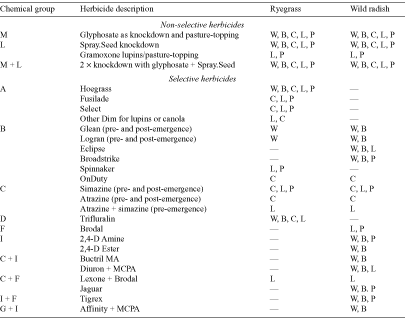The economic value of haying and green manuring in the integrated management of annual ryegrass and wild radish in a Western Australian farming system
M. Monjardino A B , D. J. Pannell B and S. B. Powles AA Western Australian Herbicide Resistance Initiative, Faculty of Natural and Agricultural Sciences, University of Western Australia, 35 Stirling Highway, Crawley, WA 6009, Australia.
B School of Agricultural and Resource Economics, University of Western Australia, c/- WA Department of Agriculture, 444 Albany Highway, Albany, WA 6330, Australia.
Australian Journal of Experimental Agriculture 44(12) 1195-1203 https://doi.org/10.1071/EA03144
Submitted: 15 July 2003 Accepted: 5 March 2004 Published: 24 January 2005
Abstract
Most cropping farms in Western Australia must deal with the management of herbicide-resistant populations of weeds such as annual ryegrass (Lolium rigidum) and wild radish (Raphanus raphanistrum). Farmers are approaching the problem of herbicide resistance by adopting integrated weed management systems, which allow weed control with a range of different techniques. These systems include non-herbicide methods ranging from delayed seeding and high crop seeding rates to the use of non-cropping phases in the rotation. In this paper, the Multi-species RIM (resistance and integrated management) model was used to investigate the value of including non-cropping phases in the crop rotation. Non-crop options investigated here were haying and green manuring. Despite them providing excellent weed control, it was found that inclusion of these non-cropping phases did not increase returns, except in cases of extreme weed numbers and high levels of herbicide resistance.
Acknowledgments
The authors acknowledge the contribution of A. Draper, R. Llewellyn and M. Walsh in reviewing this paper. The Grains Research and Development Corporation and the Cooperative Research Center for Weed Management Systems provided financial support for this research.
Firbank LG, Watkinson AR
(1985) On the analysis of competition within two-species mixtures of plants. Journal of Applied Ecology 22, 503–517.

Gill GS, Holmes JE
(1997) Efficacy of cultural control methods for combating herbicide-resistant Lolium rigidum.
Pesticide Science 51, 352–358.
| Crossref | GoogleScholarGoogle Scholar |

Gorddard RJ,
Pannell DJ, Hertzler G
(1996) Economic evaluation of strategies for management of herbicide resistance. Agricultural Systems 51, 281–298.
| Crossref | GoogleScholarGoogle Scholar |

Llewellyn RS, Powles SB
(2001) High levels of herbicide resistance in rigid ryegrass (Lolium rigidum) in the wheatbelt of Western Australia. Weed Technology 15, 242–248.

Maxwell BD,
Roush ML, Radosevich SR
(1990) Predicting the evolution and dynamics of herbicide resistance in weed populations. Weed Technology 4, 2–13.

Monjardino M,
Pannell DJ, Powles SB
(2003) A multi-species bio-economic model for management of Lolium rigidum and Raphanus raphanistrum in Australian cropping systems. Weed Science 51, 798–809.

Pannell DJ,
Stewart V,
Bennett A,
Monjardino M,
Schmidt C, Powles S
(2004) RIM: a bio-economic model for integrated weed management. Agricultural Systems 79, 305–325.
| Crossref | GoogleScholarGoogle Scholar |

Powles SB,
Preston C,
Bryan IB, Jutsum AR
(1997) Herbicide resistance: impact and management. Advances in Agronomy 58, 57–98.

Schmidt C, Pannell DJ
(1996) Economic issues in management of herbicide-resistant weeds. Review of Marketing and Agricultural Economics 64, 301–308.

Walsh MJ,
Duane RD, Powles SB
(2001) High frequencey of chlorsulfuron resistant wild radish (Raphanus raphanistrum L.) populations across the Western Australian wheatbelt. Weed Technology 15, 199–203.


|


